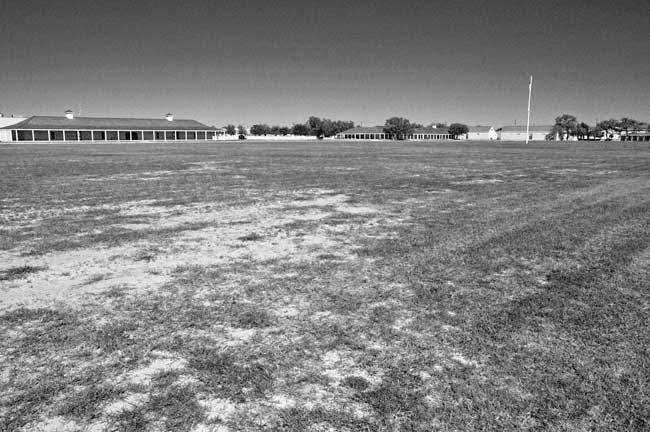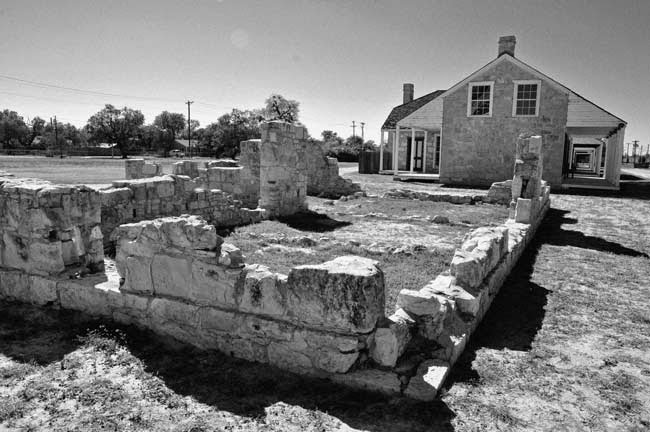Fort Concho, located in what is now the middle of San Angelo, Texas, was originally built in 1867 to protect settlers when the area was still subject to Indian attacks. The fort was actively used until it was decommissioned on June 20, 1889.
The original plans called for the construction of 40 buildings situated on 40 acres with a large, open parade ground in the middle. When the first soldiers began trying to construct the buildings with pecan wood as planned, they found the wood to be too hard and difficult to work with so they switched to using adobe bricks. However, none of the soldiers had any experience with making adobe bricks so they were mighty disappointed when almost 2 months of hard work making bricks and starting to construct buildings with them proved to be wasted when the bricks literally melted in a heavy rain storm. It was finally decided to use sandstone from several nearby quarries and to import stone masons from the town of Fredericksburg.
 |
| The parade ground of Fort Concho |
Once the Indians had been effectively removed from the area, the fort was decommissioned and abandoned and the buildings fell into disrepair. It was during this time the first reports of unexplained activity began to be heard - mysterious lights floating in and around the buildings even though nobody was there; the sound of horse's marching in the night, vague men's voices shouting commands. Before long, nobody would go near the ruins after the sun set.
 |
| Old ruins along Officers' Row |
In 1935, the city was able to purchase the old fort and began to save the 23 buildings deemed to be salvageable and started reconstruction of the other 17 from old photos and the layout of the ruins. The workers told of tools left overnight that disappeared with no trace only to mysteriously reappear several days later in the same exact spot where they had been left. In 1961, Fort Concho was declared a National Historic Landmark. Once the buildings were opened to the public, people began reporting ghostly activities mainly in 3 of the buildings; the fort's headquarters, the officers' living quarters, and the fort chapel.
 |
The current site of the visitor center and museum is
the area where the ghost of Sergeant Cunningham
is often seen. |
Although the soldiers posted at Fort Concho were active participants in several battles against Indians and Comanchero's (Mexican and American traders conducting illegal profiteering, kidnapping and looting), the battles all took place in the surrounding area and the fort was never itself attacked. Due to this, there was only one casualty recorded in the fort. Second Sergeant James Cunningham, a hard-core alcoholic, did not die in battle, but rather from cirrhosis of the liver. In spite of his nightly drinking, he had managed to report for duty each morning and was by all reports, a good soldier who was well liked by his fellow soldiers. Unfortunately, the alcohol finally caught up to him and upon being informed by the post doctor that he had only a few months to live, he was removed from active duty. A few weeks later, Sergeant Cunningham returned to the fort and requested he be allowed to spend his last days at the headquarters so he could be with his colleagues and friends, the only family he had. His request was granted. Six weeks later, he died in his sleep. A uniformed soldier has been seen walking near and even inside the old fort headquarters which has been converted into a museum. In nearly all cases, the apparition appears for only a few seconds, but the smell of whiskey will linger. Witnesses who see the ghost consistently pick out an old photograph of Sergeant Cunningham, apparently still hanging around the last earthly home he knew.
 |
| Officers' Row |
Officers' Row is the 2nd area of Fort Concho that is known to be haunted. Benjamin Grierson, the regimental commander of the 10th Calvary, lived in one of the quarters with his wife and young daughter, Edith. Shortly before Edith's 12 birthday, she became very ill and died in the upstairs bedroom. Since the building was restored, many people have told of seeing a young girl sitting on the floor of an upstairs bedroom quietly playing jacks. The game was known to be Edith's favorite and her grieving parents placed a cloth sack containing a small ball and jacks in her coffin before her burial. The bedroom where she is seen was the exact room in which the little girl breathed her last. The apparition usually appears to be oblivious to anyone who sees her, but occasionally she will look up and smile before slowly vanishing. Visitors often state that room is colder than any of the others even when no ghostly visitor is seen.
 |
Colonel Ranald MacKenzie
(historical photo) |
A 2nd ghost associated with Officers' Row is thought to be Colonel Ranald MacKenzie, the commanding officer of the fort when it was decommissioned. In letters and records, Colonel MacKenzie often stated he found Fort Concho to be one of his favorite duty stations. In fact, Colonel MacKenzie retired as the fort was decommissioned and he elected to remain, living in his home on Officers' Row until he died several years later. One December several years ago, a female staff member was working in the Mackenzie house preparing for a Christmas event. She said she heard the sound of footsteps behind her and turned to see who was there, but just as she turned, she was pushed up against the wall by a strong hand and felt a blast of cold air. Seeing nobody in the room with her, the frightened woman stood there for several seconds trying to make sense of what had just happened when she heard the sound of knuckles cracking. Before she could bolt from the room, a misty, almost transparent figure of a man in soldier's uniform materialized in front of her. It seemed to somehow be floating just above the floor and as the woman looked down, she noted the apparition seemed to be invisible below the knees. As abruptly as it appeared, the misty man disappeared. Colonel Mackenzie had been known for the habit of cracking his knuckles. There was no doubt the lady staffer had come face to face with the fort's last, and perhaps forever, commander.
The 3rd haunted building is the chapel. The chaplain, George Dunbar, was said to be a very devout Christian, a loving, devoted husband and a dedicated father to his 6 children, all of whom lived with him at the fort. He was known to get so involved in his sermons that his voice could be heard all across the fort on Sunday mornings shouting that week's message of God. After several years at Fort Concho, the chaplain was transferred to Fort Sill. It was unsafe for his wife and children to accompany him however as Fort Sill was often being attacked by renegade Indians. His family was allowed to stay at Fort Concho until it was safe for them to travel to Fort Sill and as he left one morning, he promised them he would return. Several months had passed when a messenger arrived with sad news from Fort Sill. While under attack by a large group of Commanches, one of the soldiers inside the fort had been mortally wounded. As he lay dying, Chaplain Dunbar ran to his side and began praying over him. While comforting the dying soldier, the chaplain was himself killed. He was eventually brought back to Fort Concho where his wife claimed the body and a proper burial was conducted. Today, visitors and staff report of hearing a loud and powerful male voice delivering a sermon. There have also been sightings of a soldier in uniform kneeling in prayer inside of the chapel. Occasionally, a female voice is heard accompanying the male voice, speaking quietly, perhaps in prayer. The staff likes to think this is the good chaplain's wife, the two of them spending eternity together.
Floating balls of lights, the sounds of horses being rode as if in a parade, men's voices in the middle of an empty parade ground, and even an occasional unexplained loud boom as if a ceremonial cannon has been fired are still heard today. There were no large battles with horrible loss of life at the fort, no unsolved ghastly murders, no desecrated burial grounds, so It is unknown why Fort Concho is so haunted. Perhaps not all ghosts are tortured souls unable to cross over. Perhaps Fort Concho simply was the place of good memories or circumstances in the souls of the dearly departed and it is where they are content to spend eternity. Only they know for sure.







